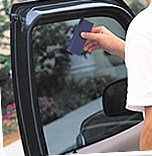
Window Tinting Films
With the hot summer months quickly approaching, now is a great time to consider window tinting films for your vehicle. Many window tinting installers offer a ‘one size fits all’ approach, but there are actually several different options to meet your needs and budget.
Benefits of Tinting Films for Your Vehicle
Aside from enhancing the appearance of your vehicle, tinting films can promote privacy, reduce glare, protect your interior from sun damage and enhance the performance of your heating and cooling system. Some tinting films may also protect you from harsh UVA and UVB ultraviolet rays.
The level of benefits you receive depends on which type of tinting film you choose
Comparing the Different Types of Tinting Films
There are four types of tinting films: dyed, metalized, carbon and ceramic. Check out the pros and cons of each option to help you figure out which type of film will work best for you.
- Dyed Window Tint Film. This is the least expensive option. Dye is placed in a layer next to the adhesive and then applied to your window. From the outside, the dyed film looks flat and opaque and can even appear black. The dye absorbs some of the heat from the sun, but the protection is minimal. Mostly, this type of film is used for appearance. One downside is that the dye tends to fade over time.
- Metalized Film. This type of film reflects heat away from the interior of your vehicle using small metallic particles embedded in the film. These particles are not visible to the eye. This type of film has a shiny appearance from the outside. The metallic content also strengthens the window, making it more shatter resistant. And it is more resistant to scratches than dyed film. However, the metallic particles may interfere with cell phone and GPS transmission in your vehicle, as well as radio reception.
- Carbon Window Tint Film. This type of film is dark and matte finished, providing a tasteful appearance from the outside. It does not contain metal, so it will not interfere with your cell phone, GPS or radio. The carbon content of the film will block about 40% of the infrared light that enters through the windows and causes heat to build up. That means it will effectively cool the inside of your vehicle, while also preventing damage to the upholstery. The carbon film also will not fade over time.
- Ceramic Film. This is the highest quality film and therefore, the most expensive. It contains a ceramic particle that is not metallic and does not conduct heat. Ceramic film eliminates 45-50% of the heat that enters through the windows in the form of infrared light, making it more effective than other types of film. Like the carbon option, it does not interfere with cell phones, GPS or radio signals. The use of the ceramic particles makes the windows highly shatter-proof and resistant to glare. It is also the most effective at blocking harmful UVA and UVB rays, reducing your risk of skin cancer.
Choosing the Right Tinting Film for Your Vehicle
Before you make your decision, be sure to check the laws that apply in your area. Many states have restrictions on window tinting, including:
- Which windows can be tinted (i.e. front, rear, side)
- Level of darkness
- Solar reflectivity
Our Auto One experts can help you select the tinting film that will work best for you. Call us today!



